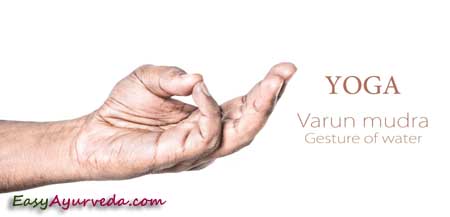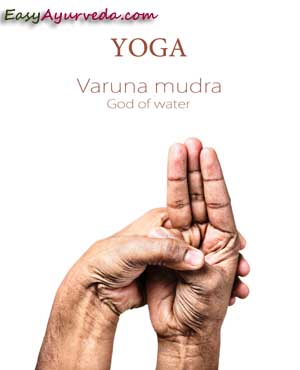Varuna Mudra Method, Benefits
The little finger represents the water element – Jala mahabhoota. Varuna is the God of rains and water, as per Hinduism. Hence this hand gesture is called Varuna Mudra. and hence this mudra is called as Varuna Mudra.
Table of Contents
Mahabhuta involved
agni (fire) and jala (earth) in the balanced state as the tips are joined.

Procedure
Sit in any comfortable posture with relaxed body and mind. Join the tips of thumb and little finger of both the hands. Straighten the other three fingers of both the hands so that they are slightly apart and relaxed. Place the hands on the knees. Concentrate on breathing pattern.

Variation
The little finger is completely flexed and the thumb is placed over it across.
Benefits
- Regular practice of this mudra helps in the proper circulation in the body.
- Due to the involvement of jala mahabhoota, dryness of skin can be reduced.
- The Varun Mudra helps in clear ideation of thoughts, smooth communication.
- Balances water element in the body.
- Balances Kapha DOsha.
- Improves blood and fluid circulation.
- Improves skin glow and skin health.
Functional factors
- BELIEF – Have faith. It is a complimentary therapy and can be used side by side with any therapy.
- MIND – Before practicing mudra, take a few deep breaths, till the breathing is rhythmic and the mind is relaxed.
- DHYANA (Meditation) – Increases the efficacy of Mudras.
- BODY – Keep the body relaxed and at ease.
Posture
- Pruthvi Mudra should be practiced with both hands.
- There should be mild pressure between the touching fingers.
- Keep unused fingers reasonably straight but not rigid; as far as possible do not move the fingers or arms while practicing mudras
- Read related: Mudra – The Science Of Gesture: Benefits, Types, How To Practice
Time
- The best time for the Sadhana is in the morning.
- Mudras should not be practiced for half to one hour after the meals
- Mudras can be safely practiced in 15-20 minutes sittings, 2-3 times a day or single sittings of 30 – 45 minutes.
- Read related: Tips To Enhance Effect Of Mudra, 5 Mudra Groups, Rules Of Hasta Mudra
Author:
Dr. Smitha Bhat
Alva’s Ayurveda Medical College,
Moodabidri, Karnataka
E mail- drsmithapbhat@gmail.com






